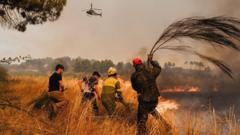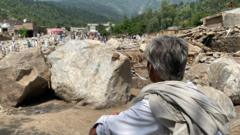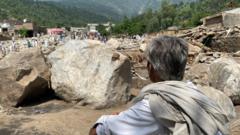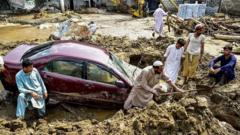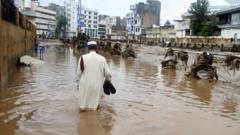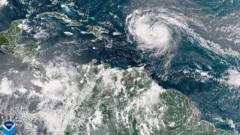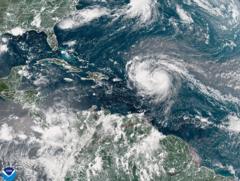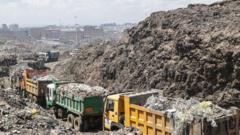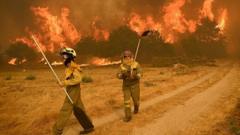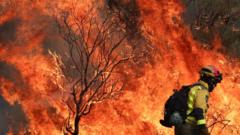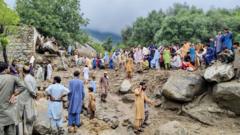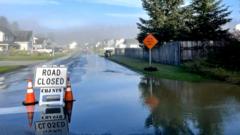Recent research reveals alarming statistics on the rapid decline of glaciers due to climate change, indicating a critical need for global action.
**Accelerating Glacier Melting Poses Global Threats**
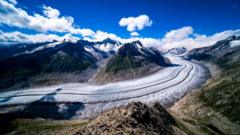
**Accelerating Glacier Melting Poses Global Threats**
Mountains of ice are disappearing at unprecedented rates, endangering ecosystems and human livelihoods worldwide.
The Aletsch Glacier, the largest in the European Alps, has shrunk about 3.2 kilometers (2 miles) since 1900, with over 1 kilometer lost just since 2000. New scientific findings suggest that glaciers are melting faster than ever recorded, driven by climate change's intensifying effects.
Glaciers, which serve as critical freshwater reserves for millions globally, contain enough ice to raise sea levels by approximately 32 centimeters (13 inches) if they were to melt entirely. Since the beginning of the 21st century, mountain glaciers have lost over 6,500 billion tonnes (5%) of ice, and the rate of ice loss has significantly accelerated. Compared to the decade of 2000-2011, glacier melting has increased by over one-third in the past decade.
The research, which compiled data from 35 teams globally and integrated over 230 estimates, emphasizes the rapid rate of glacier decline, reinforcing scientific confidence regarding the ongoing melting process. Glaciers are essential climate indicators; when a climate is stable, glaciers maintain their size, balancing gains from snowfall with losses from melting. However, rising temperatures, largely due to human activities such as fossil fuel combustion, have led to a consistent reduction in glacier sizes over the last 20 years.
From 2000 to 2023, glaciers beyond the major ice sheets in Greenland and Antarctica have averaged an ice loss of 270 billion tonnes per year. To contextualize this figure, Michael Zemp, director of the World Glacier Monitoring Service, states that this amount of ice could supply the entire global population's drinking water needs for 30 years, based on 3 liters per person daily.
Certain regions have witnessed even sharper glacier declines. For example, Central Europe has lost nearly 39% of its glacier ice in just over two decades. The novelty of the latest study, published in the journal Nature, lies not so much in the observation of accelerated melting— this has been recognized previously—but in the comprehensive approach taken to consolidate evidence from multiple scientific sources.
There are various methodologies for measuring glacier changes, each with its own pros and cons. While direct measurements yield detailed data, they cover only a small fraction of the world's 200,000 glaciers. By systematically combining different data sources, scientists can present a more reliable picture of global glacier dynamics.
Community estimates derived from this extensive research are crucial for bolstering confidence among climate scientists, policymakers, and industries concerned about the ramifications of global warming. Glaciers respond to climate changes over varying timescales, typically between several years to many decades, indicating ongoing loss in the future if current warming trends persist.
The extent of glacier loss by the century's end hinges on global temperature increases tied to carbon emissions. Projections suggest that meeting established climate targets could limit glacier loss to a quarter of the current volume, while unchecked warming could result in losses approaching half. Zemp reinforces that every fraction of a degree of avoided warming could preserve some glaciers and mitigate resultant damage.
The implications of glacier loss extend beyond localized impacts on ecosystems; they affect global water supply and sea-level rise. Thousands of millions depend on seasonal meltwater from glaciers, which serve as natural reservoirs that help mitigate drought effects. Their disappearance jeopardizes water accessibility for countless people.
Rising sea levels, driven by the loss of glaciers, ice sheets, and expanding warmer ocean waters, amplify the risk of coastal flooding. Prof. Shepherd, an expert in geography and environment, points out that every additional centimeter of sea-level rise can put 2 million more individuals at risk of annual flooding worldwide.
Since 1900, global sea levels have already risen by over 20 centimeters (8 inches), with half of that increase occurring since the early 1990s, indicating an upward trend that is expected to escalate in the coming decades. The time for meaningful action against climate change is critical, as the future viability of glaciers and their benefits to society hangs in the balance.
Glaciers, which serve as critical freshwater reserves for millions globally, contain enough ice to raise sea levels by approximately 32 centimeters (13 inches) if they were to melt entirely. Since the beginning of the 21st century, mountain glaciers have lost over 6,500 billion tonnes (5%) of ice, and the rate of ice loss has significantly accelerated. Compared to the decade of 2000-2011, glacier melting has increased by over one-third in the past decade.
The research, which compiled data from 35 teams globally and integrated over 230 estimates, emphasizes the rapid rate of glacier decline, reinforcing scientific confidence regarding the ongoing melting process. Glaciers are essential climate indicators; when a climate is stable, glaciers maintain their size, balancing gains from snowfall with losses from melting. However, rising temperatures, largely due to human activities such as fossil fuel combustion, have led to a consistent reduction in glacier sizes over the last 20 years.
From 2000 to 2023, glaciers beyond the major ice sheets in Greenland and Antarctica have averaged an ice loss of 270 billion tonnes per year. To contextualize this figure, Michael Zemp, director of the World Glacier Monitoring Service, states that this amount of ice could supply the entire global population's drinking water needs for 30 years, based on 3 liters per person daily.
Certain regions have witnessed even sharper glacier declines. For example, Central Europe has lost nearly 39% of its glacier ice in just over two decades. The novelty of the latest study, published in the journal Nature, lies not so much in the observation of accelerated melting— this has been recognized previously—but in the comprehensive approach taken to consolidate evidence from multiple scientific sources.
There are various methodologies for measuring glacier changes, each with its own pros and cons. While direct measurements yield detailed data, they cover only a small fraction of the world's 200,000 glaciers. By systematically combining different data sources, scientists can present a more reliable picture of global glacier dynamics.
Community estimates derived from this extensive research are crucial for bolstering confidence among climate scientists, policymakers, and industries concerned about the ramifications of global warming. Glaciers respond to climate changes over varying timescales, typically between several years to many decades, indicating ongoing loss in the future if current warming trends persist.
The extent of glacier loss by the century's end hinges on global temperature increases tied to carbon emissions. Projections suggest that meeting established climate targets could limit glacier loss to a quarter of the current volume, while unchecked warming could result in losses approaching half. Zemp reinforces that every fraction of a degree of avoided warming could preserve some glaciers and mitigate resultant damage.
The implications of glacier loss extend beyond localized impacts on ecosystems; they affect global water supply and sea-level rise. Thousands of millions depend on seasonal meltwater from glaciers, which serve as natural reservoirs that help mitigate drought effects. Their disappearance jeopardizes water accessibility for countless people.
Rising sea levels, driven by the loss of glaciers, ice sheets, and expanding warmer ocean waters, amplify the risk of coastal flooding. Prof. Shepherd, an expert in geography and environment, points out that every additional centimeter of sea-level rise can put 2 million more individuals at risk of annual flooding worldwide.
Since 1900, global sea levels have already risen by over 20 centimeters (8 inches), with half of that increase occurring since the early 1990s, indicating an upward trend that is expected to escalate in the coming decades. The time for meaningful action against climate change is critical, as the future viability of glaciers and their benefits to society hangs in the balance.

